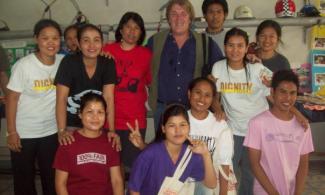
A Cooperative Network Across Global Borders (Part 1*)
No Chains began in 2009, from an encounter in Bangkok between worker cooperatives in Argentina and in Thailand – La Alameda and Dignity Returns. They undertook to build a global worker-led and sweat-free garment brand that would show not only that workers could produce affordable, quality clothes in decent conditions through their own democratic self-management, but that worker cooperatives could play a role in both national and international labor struggles for garment workers everywhere.
It was a grand ambition. Four years have now passed since the initial agreement between the two worker cooperatives in March of 2009. There have been three design competitions and clothing design launches, with the first clothing design launch and public presence of No Chains being on June 4, 2010 after more than a year of discussion, website preparation, promotion and production. The next – fourth – launch of No Chains designs will take place on June 8, 2013. In these few years, the story of No Chains has been spread widely, in many languages, with one of the most important occasions being the feature on CNN's Freedom Project: Ending Modern Day Slavery, aired on television in April 2011. (See http://thecnnfreedom.project.blogs.cnn.com/2011/04/18/victims-break-chains-of-slavery/)
Today, there are not just two, but five cooperatives in the No Chains network: besides Dignity Returns and La Alameda, there are Liza Balando Collection from the Philippines, 100% Milik Pekerja from Indonesia, and Hong Kong Women Workers' Association. This symbolically means the brand is more truly global and reflective of the industry's scope, as it now has a productive presence in more of the countries in Asia where the global garment industry has been based. On the other hand, it also has meant challenges for this small, under-resourced group of worker cooperatives. Nonetheless, the project continues, with expectations that as a collective, the needs of each individual cooperative – for example, access to customers or funds for raw materials - can be met together.
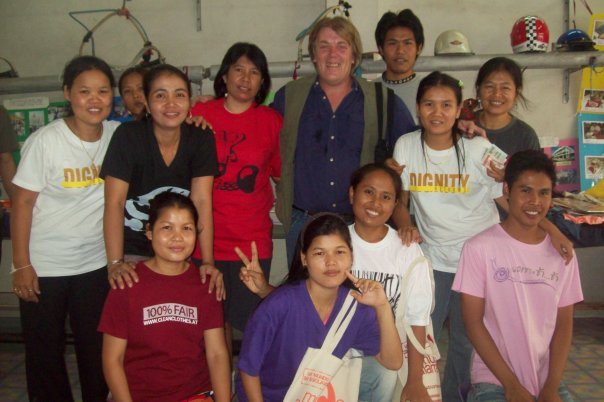
From top left to bottom right: Melona Daclan, Defend Job Philippines; Ayudya Fajri, Inkrispena; Gustavo Vera, La Alameda; Ab, No Chains Thailand, Da, observer, Manop Kraepawa and Pakjira Meechai, Dignity Returns; Doris Lee, No Chains Hong Kong; Meilin Wu, Hong Kong Women Workers' Association (picture by Doris Lee)
What makes this project unique? Can it really be a symbol promoting decent work through cooperatives, and promoting a sweat-free global garment industry through a workers' brand? Will it have the capacity to spread as a movement and as inspiration to other workers in the garment industry? A more detailed explanation of the experiences of No Chains these past four years may help one judge.
[*] Editor's Note: This article discusses only the first two of the five cooperatives in No Chains. Doris Lee will continue the story, writing about the other three, in a subsequent follow-up in GEO.]
THE START
The two cooperatives that began No Chains – La Alameda in Argentina and Dignity Returns in Thailand – remain core partners in the network. Both had their histories of working in the global garment industry – and both had struggles to claim labor rights and then – after establishing worker cooperatives – to become financially and organizationally stable.
From Struggle to Cooperative: Dignity Returns
Thipphanan Singthong ("Thip"), Dignity Returns garment worker cooperative, Thailand
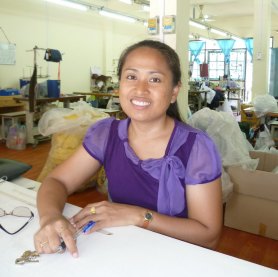 (picture by Doris Lee)
(picture by Doris Lee)
GEO: How have you changed, and what things have you learned, since becoming involved with No Chains?
Thip: I have learned different methods of working and organizing from No Chains, such as the T-shirt design contest. I also realized that I need more experience and capacity, e.g., in marketing and financing, so that I can be more effective in solving production problems. For example, one time we had too many screens being made, and it gave us a problem in negotiating prices with the screen-maker.
I also feel inspired by working with the others in No Chains, and feel that I should work hard to practice English communication. I have a family to take care of but I will try to arrange my time so that I can learn English better. One of my major worries now, however, is that we only have one main client now, and that client gives us subcontracted work, not direct orders. I hope we can improve our factory's situation somehow.
In Thailand, Dignity Returns, which was formerly called the Solidarity Factory, began as a cooperative in 2003. The workers had been fighting all the previous year against their former employer, Bed and Bath Prestige Company, which had been producing clothing for export for brands like Nike, Adidas, Gap, Reebok and UMBRO, and now had closed without paying the legally required compensation to the workers. Even after months of struggle, including marches in the streets, the workers could not get back their wages or basic compensation. With the encouragement of other labor NGOs, the workers decided to end their work in the exploitative global supply chain world, and work as a cooperative. In spite of all their written codes of conduct, the workers had been treated like slaves in the export factory, and the codes were not complied with. At times, the workers had to work 60 hours continuously. They were punished with fines for infractions such as yawning or eating lemons (to stay awake).
In 2009, at the time of encountering La Alameda, the cooperative was still in the process of pursuing financial stability. It aimed to provide each worker with a living wage; to keep working hours at eight a day; to make the factory a refuge for other Thai workers in labor struggles; and to provide a model for other workers who might want to set up cooperatives. From mainly subcontracted piece-work and 12-14 hour days in the early years, by 2009 the workers managed to have 70% of their orders from NGOs, about 5% from trade unions and only 25% from subcontracted work (which earns them the least "profit"); and their daily working hours numbered between eight and eleven. They strongly aimed for more direct orders, which would lift wages, lower working hours, and leave more time for involvement in external labor struggles or promotion of cooperatives.
Now in 2013, the cooperative is more stable, still having about 16 workers. However: the price of cotton has increased, the minimum monthly wage in Thailand has increased, and the landlord's sale of their former factory meant they had to move to a new location, incurring yet more costs for them. Furthermore, apart from sporadic direct orders for customized T-shirts, they now rely again almost exclusively on subcontracting orders from one company which gives them orders month by month.
La Alameda
The Argentine cooperative called "20 of December" is also popularly known as La Alameda. La Alameda is the name of a bar that was taken over by the popular assembly (a neighborhood organization, established by residents to solve community needs, and not linked with official government) in the area of Parque Avellaneda in Buenos Aires. That assembly began to solve the problems of the residents first by starting a community canteen, which ultimately became a program of the city under the Secretary of Social Development, feeding 140 people each day.

La Alameda member and comrades, with the loyal supporter of several years, Cardinal Jorge Bergoglio, now Pope Francis (picture by Doris Lee)
Later, the group, now called La Alameda after the bar, also began to search for other forms of solidarity to generate work for the residents, and the garment worker cooperative was one. As more workers, especially migrant Bolivians, came to the community canteen, La Alameda members would learn about problems such as hidden urban sweatshops, sex trafficking, and child labor on poultry farms. From some of the former sweatshop workers, La Alameda organized cooperatives, and one is "20 of December", which is the formal name of La Alameda's garment worker cooperative in No Chains.
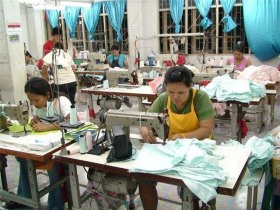
Workers at Dignity Returns factory, Bangkok, Thailand (picture by Doris Lee)
Since 2009 La Alameda has become very highly visible for its work in exposing garment sweatshops, denouncing sweatshop owners, and exposing government collusion or inaction in prostitution rings and sex trafficking. One of the trademark strategies of La Alameda to support workers' rights and restrict abuses of employers is using hidden cameras, and making high media impacts to generate public discussions about abuse of migrant labor. Another is to partner with respected and politically independent public figures who would give support to their cause. The new Pope – formerly Cardinal Jorge Mario Bergoglio – was one of the supporters; he held outdoor services with the excluded (sweatshop workers, waste recyclers), together with La Alameda. His expressions of support have been frequent and these have lent great moral weight to the struggles to end labor and human rights abuses of migrant workers.
THE REALITY
Though in many respects the types of pressures and work conditions faced by the workers in the two cooperatives were the same, the process of working together as cooperatives from different places has required immense additional efforts. To begin with, the cooperative members do not speak a common language. Other volunteers in Thailand and I have been playing intermediary roles to ensure that discussions and decision-making are always conducted in Thai, English, and Spanish. Thus, many discussions take a long time and it also takes time to get accustomed to those from different cultures. Yet as activists and cooperative workers, the workers' time is very limited. Furthermore, No Chains heavily needs marketing, and this also requires big efforts – for drafting, printing, translating ...
Doris Lee, coordinator of No Chains
GEO: What is your role in No Chains? How did you get involved and what has your involvement meant for you?
Doris: My role in No Chains is mainly to communicate and coordinate between the different factories and organizations. Through email and Skype, we have meetings and propose ideas, make decisions, share problems, etc. This is done also with the help of other volunteer coordinators and interpreters in each country who are working with the cooperatives. When possible, we find occasions to meet in person. I also help with external networking and promotion.
I first got involved when a member of La Alameda from Argentina was invited to Bangkok for a labor conference organized by AMRC, the labor NGO where I used to work as editor. When the activist, Gustavo Vera, learned that there was a worker-managed garment cooperative in Bangkok with a similar history as the worker cooperative of La Alameda, he proposed that the two jointly set up a workers' brand, which would produce clothing by workers in cooperatives and would call for a garment industry free of exploitation. I thought it would be difficult to sustain, considering the language barriers, but I also believed it would be a very unique form of cooperation, one in which worker-to-worker solidarity across borders would be 'built-in' – i.e., the success of the project would be built upon the efforts of workers in different places to understand and to help each other. It would be a meaningful medium through which the hard–learned lessons of worker struggle and cooperative survival get passed on to others who are also struggling.
I have indeed learned a lot through my involvement with No Chains, and feel more motivated than ever to continue.
Finally, establishing a common sales and finance system is also complicated. The difficulty here is one reason why, after several years, the profit-sharing system has been changed. Initially, each cooperative would share half of their surplus with the other. But with five cooperatives in five countries, the principle is extremely impractical to implement: this is due to the sometimes small or absent surplus, the different currencies, and the lack of accounting expertise. Instead, each cooperative will set aside 20% of their profits to be shared in a common No Chains fund, the use of which will be decided collectively among the cooperatives, but generally are intended for the continued campaigning and marketing of No Chains, and for particular needs of the cooperatives. For example, previously shared surpluses were used for organizing launch events, or for raw material for the new cooperatives' first production runs. In this manner, the No Chains cooperatives have been relying on their shared resources to solve problems within the network.
All these are huge challenges for the cooperatives, and the members are constantly searching for ways to address them.
WHAT READERS CAN DO
The dominant structures of garment production, retailing, and purchasing are heavily weighted to favor those with large amounts of capital and marketing capacity – not small groups of workers. Some of the public may sympathize with workers like those in No Chains, who want to produce garments, but without being exploited. The question is how? Here are some suggestions:
First of all, the network needs clients and distribution partners – organizations that can order and distribute No Chains shirts for the 4th design launch on June 8 (the winning designs will soon be posted on www.nochains.org [website no longer functioning in 2019. -ed.] ), as well as later designs of No Chains shirts. They should be willing to work together as "inside'" partners, as the cooperatives develop their capacity to directly handle setting prices, making sales, producing at a consistent high quality level, etc.
Secondly, the cooperatives – especially the newer ones - would benefit by learning particular skills such as setting prices, keeping accounts, marketing, quality control and following up with orders.
Thirdly, promotion world-wide of the value and operation of workplace democracy and of No Chains is still needed – sharing about the actual conditions of garment production in Latin America and Asia, vs. the worker-managed production of No Chains and other worker cooperatives.
Fourthly, other cooperatives could share with the No Chains cooperatives how they, within a cooperative movement, or within a labor movement, achieved legislative or other practical measures that punish exploitative employers and facilitate workers' unionization or self-management in a cooperative form.
Finally, outright donations are actually needed at this stage. Some of the cooperatives do not have a stable production location – debt is incurred in order to rent, or there is no central location and sewing must still be done in individual homes. This reduces productivity greatly. Also some of the machines are of limited type only – reducing the range of clothing that can be produced by the workers. In the absence of donations, it will either take a long time for the No Chains network to accumulate funds to meet these needs, or some of the cooperatives may be forced to disband and re-enter the exploitative garment supply chain, burdened by handicaps of age and possible stigma for past labor activism.
To offer your cooperation in any of these areas, please contact Doris Lee, No Chains, at NoChains Email or Personal Email.
Citations
Doris Lee (2013). No Chains: A Cooperative Network Across Global Borders (Part 1*). Grassroots Economic Organizing (GEO). https://geo.coop/story/no-chains

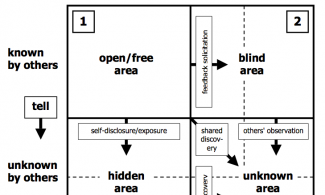

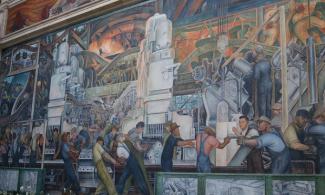
Add new comment